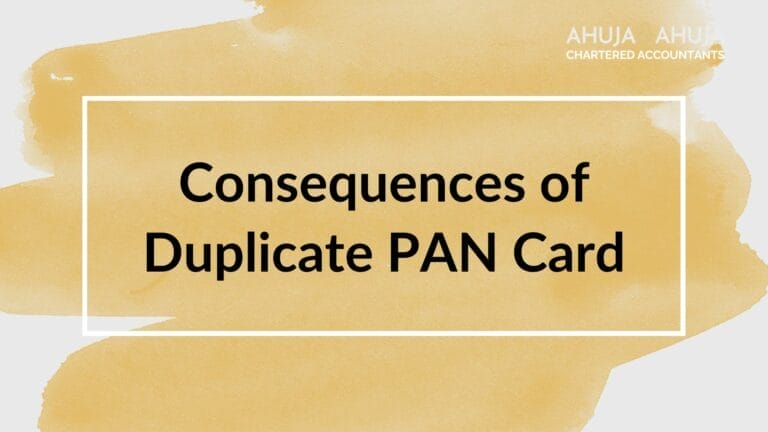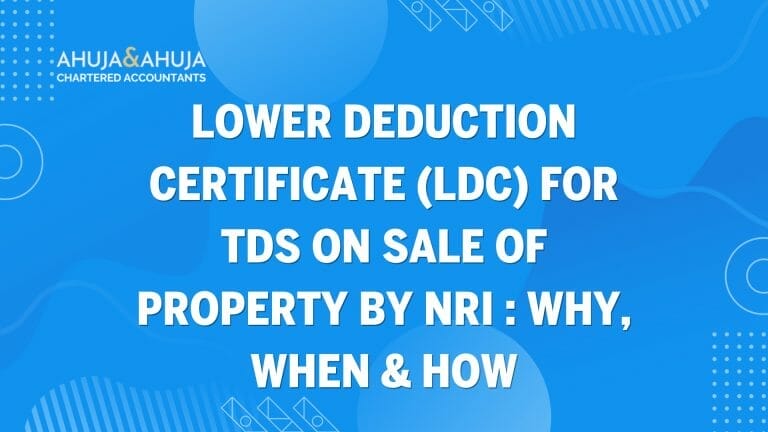TDS on Crypto / NFT / Virtual Digital Assets Explained (Section 194S)
The landscape of investments and financial assets has profoundly transformed with the integration of digital technology.
Among these advancements, Virtual Digital Assets (VDAs) such as cryptocurrencies and Non-Fungible Tokens (NFTs) have emerged as prominent elements.
With the growing traction of these digital assets, it becomes imperative to define and streamline the tax implications associated with their transactions.
Accordingly, the Finance Act 2022 introduced Section 194S in the Income Tax Act, 1961, effective from July 1, 2022.
This section specifically mandates the deduction of Tax Deducted at Source (TDS) on the payment made on the transfer of VDAs.
Why Understanding Section 194S is Crucial?
The incorporation of Section 194S into the Income Tax Act is a significant move towards regulating the fiscal aspects of digital asset transactions.
It not only outlines the tax liabilities but also aids in maintaining a systematic record of all transactions involving VDAs which can be instrumental in curbing tax evasion and fostering transparency.
Individuals and entities dealing in or investing in VDAs must comprehend the nuances of Section 194S to ensure compliance and efficient tax planning.
For detailed insights into efficient tax strategies and to keep up with related income tax norms, consider exploring services like income tax return filing and corporate tax services.
Defining Virtual Digital Assets (VDAs)
Before delving deeper into the specifics of TDS under Section 194S, it is crucial to understand what constitutes a Virtual Digital Asset under the Income Tax Act. As defined, VDAs include the following:
- Cryptocurrencies and tokens: Digital currencies like Bitcoin, Ethereum, and various utility tokens that are used in digital transactions and held as digital assets.
- Non-Fungible Tokens (NFTs): Unique digital tokens representing ownership or proof of authenticity of digital or physical assets, often associated with art, collectibles, and media.
- Other digital assets notified by the Government: This includes any digital representation of value which is notified by the central government as a VDA.
The widening scope of VDAs necessitates an understanding of the tax implications for ensuring regulatory compliance and making informed financial decisions regarding digital assets.
Relevance of VDAs in the Modern Digital Economy
The digital economy has been expanding at an unprecedented rate, and VDAs have played a pivotal role in this growth.
From being used as investment vehicles to facilitating secure digital transactions in various compliance-bound industries, VDAs are becoming indispensable.
Moreover, as businesses increasingly adopt blockchain technology, the importance of understanding the financial and tax-related aspects of VDAs will continue to grow.
For those interested in learning more about capital gains tax exemptions which are critical when managing assets, please refer to the guide on Section 54 which deals with tax exemptions on residential property sales.
As we have set the stage with these fundamentals, the next parts of the article will dive into the key aspects of Section 194S, detailing the conditions, compliance requirements, and the roles of different parties involved in the transactions pertaining to VDAs.
This knowledge is not only essential for taxpayers who are directly engaging with VDAs but also useful for accounting and finance professionals navigating this evolving space.
The goal is to unfold the complexities of Section 194S in a manner that is comprehensible and accessible to all, ensuring that every stakeholder is well-informed and prepared to handle their digital asset transactions in accordance with the law.
Key Aspects of Section 194S: Understanding TDS on Virtual Digital Assets
Navigating the newly implemented Section 194S of the Income Tax Act requires a clear understanding of various conditions and transaction scenarios wherein Tax Deducted at Source (TDS) becomes applicable.
This section carefully outlines the tax liabilities for different parties involved in the transfer of Virtual Digital Assets (VDAs).
Overview of TDS Liability on VDAs
Section 194S mandates a 1% TDS deduction from payments made on account of VDA transactions when certain conditions are met. The thresholds for these deductions are:
- Rs 50,000 during the financial year for specified persons.
- Rs 10,000 during the financial year for other individuals.
Specified persons generally include individuals or Hindu Undivided Families (HUFs) that do not have income under the ‘profits and gains of business and profession’ and those whose business income is up to Rs 1 crore or professional receipts up to Rs 50 lakh.
Detailed Transaction Guidelines
Transactions in Cash Through an Exchange
When a Virtual Digital Asset transaction occurs via an exchange that does not own the VDA, different parties may be involved, such as buyers, brokers, and sellers.
Here’s how TDS comes into play:
- Payment Process: Typically, a buyer makes a payment to the exchange, either directly or through a broker. The exchange, in turn, is responsible for paying the seller.
- TDS Responsibility: The exchange must deduct TDS at the rate of 1% while making the payment to the VDA owner. If there are multiple brokers involved between the buyer and the exchange, the responsibility of deducting TDS may lie with the broker facilitating the final payment to the seller.
- Form Compliance: The exchanges are required to report these transactions quarterly using Form No. 26QF.
In-Kind Transactions and Bartering
Transactions may not always be in cash but could involve the barter of one VDA for another or part payment in kind. In such scenarios:
- TDS Application: TDS should still be deducted based on the fair market value of the VDAs exchanged.
- Reporting: If the transaction is facilitated by an exchange, the exchange must report this transaction in the appropriate tax form.
If private individuals are involved without the mediation of an exchange, they need to handle TDS deduction and reporting independently.
The government has also provided provisions for TDS deduction when VDAs are exchanged for another VDA, reflecting in the tax forms dedicated for such disclosures (Form No. 26Q for regular transactions and Form No. 26QE for specified persons).
Tax Deduction Requirements
Tax under Section 194S should be deducted at the rate of 1%. However, if the PAN of the payee is not provided, the deduction rate escalates to 20%.
It is essential to understand that no tax needs to be deducted if the transaction does not exceed the specified thresholds for specified and other individuals.
Reporting and Compliance
Adhering to compliance requirements is crucial:
- Form 26Q must be used for reporting transactions by non-specified persons while Form 26QE is for specified persons.
- Time Frame for TDS: TDS deducted during a month must be deposited by the seventh day of the subsequent month.
- Quarterly Reporting: The payer must file TDS returns quarterly within the stipulated deadlines to avoid penalties.
Considering the implications of these guidelines on transactions and compliance can influence tax planning and management strategies for individuals and businesses dealing in VDAs.
For comprehensive understanding and management of the intricacies involved in tax deductions when buying a house property in joint names, you may refer to the insights provided here.
Interactions with Other Tax Sections and FAQs
Understanding how Section 194S interacts with other tax provisions, particularly Section 194O, and exploring frequently asked questions can provide further clarity and aid in compliance.
TDS Interaction: Section 194S and 194O
The Income Tax Act includes various sections dealing with TDS, among which Section 194O also plays a crucial role, especially for e-commerce transactions. It’s essential to distinguish between these provisions:
- Section 194S: Applies specifically to transactions involving Virtual Digital Assets (VDAs).
- Section 194O: Relates to payments made by e-commerce operators to their participants.
Where applicable, if TDS has already been deducted under Section 194S, then no additional TDS deduction is required under Section 194O.
This avoids dual TDS deductions on the same transaction, simplifying tax obligations for involved parties.
Additionally, while calculating the TDS to be deducted under Section 194S, any Goods and Services Tax (GST) included in the transaction value should be excluded from the TDS calculation base, ensuring that TDS is only applied to the net transaction amount relating to the VDA.
Frequently Asked Questions (FAQs)
What is the rate of tax to be deducted under Section 194S?
- The TDS rate under Section 194S is 1% of the transaction value. However, if the PAN is not furnished by the payee, the rate increases to 20%.
What is considered a Virtual Digital Asset for TDS purposes?
- A VDA refers to any information, code, number, or token generated through cryptographic means, commonly known as cryptocurrency (e.g., Bitcoin, Ethereum), a Non-Fungible Token (NFT), or any other token of similar nature as notified by the Government.
What are the transaction thresholds for not deducting TDS under Section 194S?
- No TDS is required if the transaction value does not exceed Rs. 50,000 for specified persons or Rs. 10,000 for others in a financial year.
Is it mandatory to have a Tax Deduction and Collection Account Number (TAN) for deducting TDS under Section 194S?
- Unlike other sections, TAN is not mandatory for deducting TDS under this specific section, making it more accessible for individuals not regularly engaged in business or profession.
What is the deadline for filing Form 26QE?
- TDS deducted under Section 194S should be reported on Form 26QE within 30 days from the end of the month in which the TDS was deducted.
For further insights into effective bookkeeping and compliance frameworks, particularly for NGOs under the Income Tax Act, check out the overview on Rule 17AA and the requirements for books of accounts for NGOs.
Conclusion
The inclusion of Section 194S in the Income Tax Act elaborates the tax implications and reporting requirements for transactions involving Virtual Digital Assets, integrating these modern assets into the formal economic framework.
By understanding and adhering to the guidelines, taxpayers can ensure compliance, optimize their tax liabilities, and contribute to a transparent digital economy.
Whether you are an individual investor, a financial professional, or a business entity engaging with digital assets, grasping these nuances is essential for effective financial management and compliance in the digital age.
This comprehensive guide hopes to have provided you with valuable insights into the workings of Section 194S, preparing you to navigate the complexities of tax deductions in the realm of Virtual Digital Assets skillfully.
Disclaimer
The materials provided herein are solely for educational and informational purposes. No attorney/professional-client relationship is created when you access or use the site or the materials. The information presented on this site does not constitute legal or professional advice and should not be relied upon for such purposes or used as a substitute for professional or legal advice.






